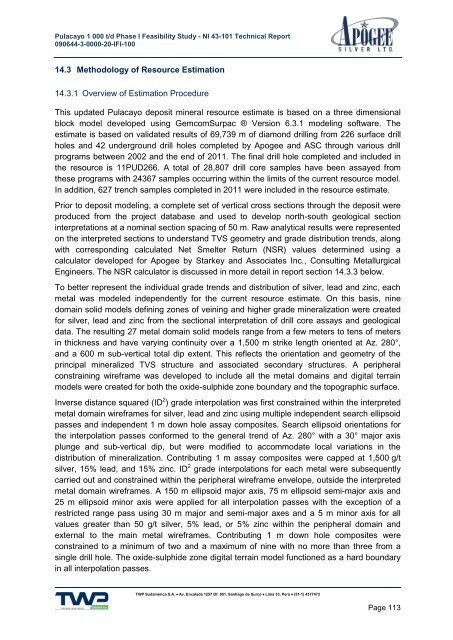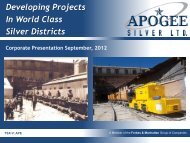Pulacayo Project Feasibility Study - Apogee Silver
Pulacayo Project Feasibility Study - Apogee Silver
Pulacayo Project Feasibility Study - Apogee Silver
You also want an ePaper? Increase the reach of your titles
YUMPU automatically turns print PDFs into web optimized ePapers that Google loves.
<strong>Pulacayo</strong> 1 000 t/d Phase I <strong>Feasibility</strong> <strong>Study</strong> - NI 43-101 Technical Report<br />
090644-3-0000-20-IFI-100<br />
14.3 Methodology of Resource Estimation<br />
14.3.1 Overview of Estimation Procedure<br />
This updated <strong>Pulacayo</strong> deposit mineral resource estimate is based on a three dimensional<br />
block model developed using GemcomSurpac ® Version 6.3.1 modeling software. The<br />
estimate is based on validated results of 69,739 m of diamond drilling from 226 surface drill<br />
holes and 42 underground drill holes completed by <strong>Apogee</strong> and ASC through various drill<br />
programs between 2002 and the end of 2011. The final drill hole completed and included in<br />
the resource is 11PUD266. A total of 28,807 drill core samples have been assayed from<br />
these programs with 24367 samples occurring within the limits of the current resource model.<br />
In addition, 627 trench samples completed in 2011 were included in the resource estimate.<br />
Prior to deposit modeling, a complete set of vertical cross sections through the deposit were<br />
produced from the project database and used to develop north-south geological section<br />
interpretations at a nominal section spacing of 50 m. Raw analytical results were represented<br />
on the interpreted sections to understand TVS geometry and grade distribution trends, along<br />
with corresponding calculated Net Smelter Return (NSR) values determined using a<br />
calculator developed for <strong>Apogee</strong> by Starkey and Associates Inc., Consulting Metallurgical<br />
Engineers. The NSR calculator is discussed in more detail in report section 14.3.3 below.<br />
To better represent the individual grade trends and distribution of silver, lead and zinc, each<br />
metal was modeled independently for the current resource estimate. On this basis, nine<br />
domain solid models defining zones of veining and higher grade mineralization were created<br />
for silver, lead and zinc from the sectional interpretation of drill core assays and geological<br />
data. The resulting 27 metal domain solid models range from a few meters to tens of meters<br />
in thickness and have varying continuity over a 1,500 m strike length oriented at Az. 280°,<br />
and a 600 m sub-vertical total dip extent. This reflects the orientation and geometry of the<br />
principal mineralized TVS structure and associated secondary structures. A peripheral<br />
constraining wireframe was developed to include all the metal domains and digital terrain<br />
models were created for both the oxide-sulphide zone boundary and the topographic surface.<br />
Inverse distance squared (ID 2 ) grade interpolation was first constrained within the interpreted<br />
metal domain wireframes for silver, lead and zinc using multiple independent search ellipsoid<br />
passes and independent 1 m down hole assay composites. Search ellipsoid orientations for<br />
the interpolation passes conformed to the general trend of Az. 280° with a 30° major axis<br />
plunge and sub-vertical dip, but were modified to accommodate local variations in the<br />
distribution of mineralization. Contributing 1 m assay composites were capped at 1,500 g/t<br />
silver, 15% lead, and 15% zinc. ID 2 grade interpolations for each metal were subsequently<br />
carried out and constrained within the peripheral wireframe envelope, outside the interpreted<br />
metal domain wireframes. A 150 m ellipsoid major axis, 75 m ellipsoid semi-major axis and<br />
25 m ellipsoid minor axis were applied for all interpolation passes with the exception of a<br />
restricted range pass using 30 m major and semi-major axes and a 5 m minor axis for all<br />
values greater than 50 g/t silver, 5% lead, or 5% zinc within the peripheral domain and<br />
external to the main metal wireframes. Contributing 1 m down hole composites were<br />
constrained to a minimum of two and a maximum of nine with no more than three from a<br />
single drill hole. The oxide-sulphide zone digital terrain model functioned as a hard boundary<br />
in all interpolation passes.<br />
TWP Sudamérica S.A. Av. Encalada 1257 Of. 801, Santiago de Surco Lima 33, Perú (51-1) 4377473<br />
Page 113



